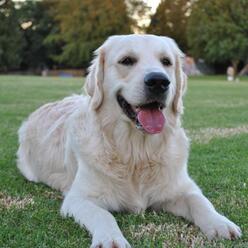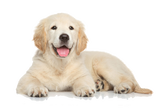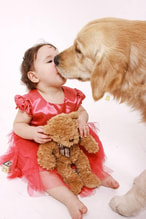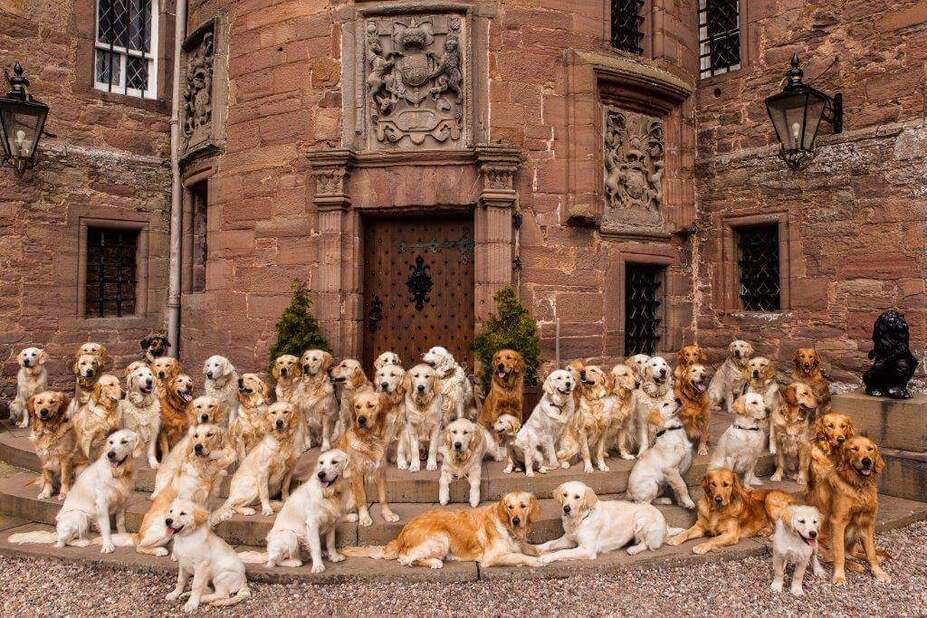Information about The Golden Retriever
Below is more information about the Golden Retriever Breed, Acceptable Breeding Practices and how to go about selecting a Breeder. Please navigate through the tabs as required.
-
Temperament & Characteristics
-
The Breed Standard
-
History of the Breed
<
>
Temperament & Characteristics

The Golden is a medium-to-large size dog who requires a good bit of space indoors and out. Everything about the dog is big, including his hairy paws, which will track mud and dirt onto your floor. His happy wagging tail will sweep your prized glassware from low-standing table tops. His natural curiosity will lead to rows of nose prints on the glass above your windowsills. Given a single opportunity, he will claim at least two couch cushions or your easy chair. The youngest and most beautiful of the retriever breeds, the Golden Retriever was originally developed as a waterfowl dog. Although still an admirable shooting dog, the Golden today spends more time romping with the family than in the duck blind or the field. Often considered the ideal dog to hunt over, compete with or just live with and hug a lot, the Golden has something to offer the sportsman, dog fancier or professional dog lover.
Remember that your cute, fluffy puppy will grow into a large vigorous dog, who will need looking after for up to 15 years. Like a child, it depends on you to provide its nutrition, education and overall well-being. Consider the amount of time you can dedicate to your dog, the space available in your home, the cost of veterinary attention and most importantly, your dog’s essential food requirements – Goldens are among the dog world’s greatest eaters!
History of the Breed
|
Before acquiring a Golden Retriever it is important to determine if a Golden Retriever is the correct / suitable breed for you, your household and your lifestyle.
Golden Retrievers were first accepted for registration by the The Kennel Club of England in 1903, as Flat Coats - Golden. They were first exhibited in 1908, and in 1911 were recognized as a breed described as Retriever (Golden and Yellow). In 1913, the Golden Retriever Club was founded. The breed name was officially changed to Golden Retriever in 1920. The original cross was of a yellow-coloured Retriever, Nous, with a Tweed Water Spaniel female dog, Belle. The Tweed Water Spaniel female dog, Belle. The Tweed Water Spaniel is now extinct but was then common in the border country. Majoribanks had purchased Nous in 1865 from an unregistered litter of otherwise black wavy-coated retriever pups. In 1868, this cross produced a litter that included four pups; these four became the basis of a breeding program which included the Irish Setter, the sandy-colored Bloodhound, the St. John's Water Dog of Newfoundland, and two more wavy-coated black Retrievers. |
The bloodline was also inbred and selected for trueness to Majoribanks' idea of the ultimate hunting dog. His vision included a more vigorous and powerful dog than previous retrievers, one that would still be gentle and trainable. Russian sheepdogs are not mentioned in these records, nor are any other working dog breeds. The ancestry of the Golden Retriever is all sporting dogs, in line with Majoribanks' goals.
The Honorable Archie Majoribanks took a Golden Retriever to Canada in 1881, and registered Lady with the American Kennel Club (AKC) in 1894. These are the first records of the breed in these two countries. The breed was first registered in Canada in 1927, and the Golden Retriever Club of Ontario, now the Golden Retriever Club of Canada, was formed in 1958. The co-founders of the GRCC were Cliff Drysdale an Englishman who had Kennels, possibly Cann and Jutta Baker, daughter in law of Louis Baker who owned Northland Kennels, possibly Canada's first kennel dedicated to Goldens. The AKC recognized the breed in 1925, and in 1938 the Golden Retriever Club of America was formed. Golden Retriever Club of Scotland celebrated it's 60th Anniversary hosting a special weekend on 30th - 31st July 2006 at Guisachan House ruins and in the conservation village of Tomich. |
In all purebred canines, a "Breed Standard" has been adopted by various kennel clubs in the world. In South Africa, the Kennel Union of South Africa (KUSA) has a specific breed standard for the Golden Retriever. Please visit their website on www.kusa.co.za for more information, or alternatively contact us for more information. It is true that many countries has different breed standards for the same type of dog - for example the American breed standard for the Golden Retriever differs from the South African or United Kingdom. It is a good idea to familiarise yourself with the breed standard to be able to ascertain whether you are purchasing a purebred Golden Retriever if you are not familiar with the breed.
The world's friendliest dog, the Golden Retriever is also counted amongst the most talented and popular of companion dogs. Renowned for its lustrous golden coat, his buoyant personality and his lusty desire to hunt, the Golden Retriever makes an ideal pet dog for young and old alike. His winning ways and easy-to-train temperament account for his great popularity and success in every field.
The world's friendliest dog, the Golden Retriever is also counted amongst the most talented and popular of companion dogs. Renowned for its lustrous golden coat, his buoyant personality and his lusty desire to hunt, the Golden Retriever makes an ideal pet dog for young and old alike. His winning ways and easy-to-train temperament account for his great popularity and success in every field.
Information about Breeding and Breeding Practices
-
Responsible Breeding
-
Health & Genetics
-
Why Showing is Important
-
What is a Registered, Pedigreed Dog?
<
>
Goldens, like most large breed dogs, are predisposed to Hip and Elbow Dysplasia. There are 3 roll players in this disease; Genetics, Environment and Nutrition.
To minimise the risk of producing puppies with Hip Dysplasia, reputable breeders have their breeding stock's hips and elbows X-rayed once they reach adulthood (at 12 - 18 months of age). These X-rays are examined and scored by a radiologist. Only dogs with acceptable scores are then bred from. Unfortunately there is room for error as this is not a genetic test but merely states that the specific dog is free from radiographical changes. This does not mean that the dog is genetically free from Hip or Elbow Dysplasia merely that the dog shows no sign of the disease. At this stage there is no genetic test available for Hip or Elbow Dysplasia.
To minimise the risk of producing puppies with Hip Dysplasia, reputable breeders have their breeding stock's hips and elbows X-rayed once they reach adulthood (at 12 - 18 months of age). These X-rays are examined and scored by a radiologist. Only dogs with acceptable scores are then bred from. Unfortunately there is room for error as this is not a genetic test but merely states that the specific dog is free from radiographical changes. This does not mean that the dog is genetically free from Hip or Elbow Dysplasia merely that the dog shows no sign of the disease. At this stage there is no genetic test available for Hip or Elbow Dysplasia.
Genetics
Genetic diseases affect many canine breeds. To date, there is no cure for any canine genetic diseases. Consequently, affected canines may experience painful, distressed and often shortened lifespans. The genetic tests on offer at inqaba biotec™ are able to determine whether your canine family member is clear of a disease, is a carrier for the disease or is affected by the disease.
Below information is from Inqaba Biotec website directly: https://www.inqababiotec.co.za/service/animal-genetics/
The Animal Genetics Department at Inqaba Biotechnical Industries (Pty) Ltd provides a myriad of accurate genetic tests (health, colour, DNA fingerprinting) to the domestic, livestock and wildlife industries.
Mochavulin Golden Retrievers pride ourselves that we were the first Golden Retriever breeders to start with DNA testing and others have slowly followed our example. With more tests becoming available, we will continue to DNA test our dogs to get the most information and best information possible when we decide to breed our dogs. We will not breed with affected dogs.
Tests currently relevant for Golden Retrievers:
- Degenerative Myelopathy (SOD1)
- Centronuclear Myopathy (PTPLA)
- Hereditary Nasal Parakeratosis (SUV39H2)
- Copper Storage Disease (ATP7B)
- Progressive Retinal Atrophy (PRCD)
- Progressive Retinal Atrophy (GR_PR1)
- Progressive Retinal Atrophy (GR_PR2)
- Neuronal Ceroid Lipofuscinosis (CLN5)
- Cleft Palate (DXL6)
- Cleft Palate (ADAMTS20)
- Exercise Induced Collapse (NEI)
- WHAT IS Degenerative Myelopathy (SOD1) - Canine degenerative myelopathy, also known as chronic degenerative radiculomyelopathy, is an incurable, progressive disease of the canine spinal cord that is similar in many ways to amyotrophic lateral sclerosis.
- WHAT IS Centronuclear Myopathy (PTPLA) - Centronuclear myopathy is a condition characterized by muscle weakness (myopathy) and wasting (atrophy) in the skeletal muscles, which are the muscles used for movement. ... People withcentronuclear myopathy begin experiencing muscle weakness at any time from birth to early adulthood.
- WHAT IS Hereditary Nasal Parakeratosis (SUV39H2) - Hereditary Nasal Parakeratosis (HNPK) is an inherited autosomal recessive disorder in Labrador Retrievers. ... Symptoms of the disorder generally appear around 6 to 12 months of age. Affected dogs develop dry, rough, and gray or brown crusts on the surface and edge of the nose.
- WHAT IS Copper Storage Disease (ATP7B) - Copper storage hepatopathy is a condition caused by an abnormal accumulation of copper in the animal's liver, which leads to progressive damage and scarring of the liver (cirrhosis). This condition may be secondary to a primary disease or the result of genetic-based abnormal copper metabolism.
- WHAT IS Progressive Retinal Atrophy (PRCD) - Progressive retinal atrophy is a group of genetic diseases seen in certain breeds of dogs and, more rarely, cats. Similar to retinitis pigmentosa in humans, it is characterized by the bilateral degeneration of the retina, causing progressive vision loss culminating in blindness.
- Progressive Retinal Atrophy (GR_PR1)
- Progressive Retinal Atrophy (GR_PR2)
- WHAT IS Neuronal Ceroid Lipofuscinosis (CLN5) - The neuronal ceroid lipofuscinoses are a group of inherited lysosomal storage disorders. ... NCL affected dogs lack one of several enzymes necessary for the normal breakdown of certain types of fat or protein in the cells (called lipopigments.)
- WHAT IS Cleft Palate (DXL6) - Canine Cleft Palate. ... It is the result of failure of the two sides of the palate (roof of the mouth) to come together and fuse during embryonic development. Acleft palate results in an opening between the nasal passages and the mouth.
- Cleft Palate (ADAMTS20)
- WHAT IS Exercise Induced Collapse (NEI) - Exercise-Induced Collapse (EIC) is an autosomal recessive genetic disorder causing affected dogs to suffer from a loss of muscle control following periods of extreme exercise. ... EIC episodes generally occur after 5-25 minutes of extreme exercise.
Nutrition
Nutrition is the other and most controllable variable in this equation. With a large breed dog one has to prevent the puppy from growing too fast and this can be done through nutrition. We feed Hill's Science Plan Large Breed Puppy, Eukanuba, Royal Canin, Origin or Acana to our puppies and insist that our owners do the same. One of the most detrimental factors for Hip Dysplasia is an overweight puppy or dog. It has been proved that dogs that are overweight are 50% more likely to develop Hip Dysplasia than their littermates at ideal weight.
Environment
Environment and how the puppy is raised plays a hugely important part in whether a puppy will develop Hip and Elbow Dysplasia or not. Jumping over obstacles, in and out of cars, slipping on floors, over-exercising can all lead to a puppy developing these problems. It is therefore essential that you are cautious with a puppy's activities until it is at least 12 months old. If your puppy has an accident at this stage (like falling off something) they probably will develop a joint problem. On the other hand, Hip Dysplasia is by no means a death sentence and most Goldens with this problem cope extremely well into old age. In this day and age there are also many ways of maintaining a dog with joint problems, such as nutrition.
Eye Disease
Goldens, once again like many other breeds, are predisposed to many eye diseases as well. To avoid producing puppies with problems, reputable breeders have their breeding stock screened annually. Once again, these certificates only state that the dog in contention does not have the disease/s at the time of the screening. Unfortunately there are as yet no genetic tests available for eye diseases in Golden Retrievers (some other breeds such as Labrador Retrievers, have DNA tests available for some of the eye diseases. Although these certificates cannot assure one of never producing an affected puppy, at least by testing, reputable breeders are not breeding with affected dogs and therefore minimising the risk of producing affected puppies.
Why is Showing or getting a Title for your dog important?
Not just a brag, not just a stepping stone to a higher title, not just an adjunct to competitive scores, a title is a tribute to the dog that bears it, a way to honor the dog, an ultimate memorial. It will remain in record and in memory for as long as anything in this world can remain. Few humans will do as well or better in that regard.
And though the dog itself doesn't know or care that its achievements have been noted, a title says many things in the world of humans, where such things count.
A title says your dog was intelligent and adaptable, and good-natured. It says that your dog loved you enough to do the things that please you, however crazy they may have sometimes seemed.
And a title says that you loved your dog, that you loved to spend time with it because it was a good dog, that you believed in it enough to give it yet another chance when it failed, and that, in the end, your faith was justified.
A title proves that your dog inspired you to that special relationship enjoyed by so few; that in a world of disposable creatures, this dog with a title was greatly loved, and loved greatly in return.
And when that dear short life is over, the title remains as a memorial of the finest kind, the best you can give to a deserving friend, volumes of pride in one small set of initials after the name.
A title earned is nothing less than love and respect, given and received, and permanently recorded.
And though the dog itself doesn't know or care that its achievements have been noted, a title says many things in the world of humans, where such things count.
A title says your dog was intelligent and adaptable, and good-natured. It says that your dog loved you enough to do the things that please you, however crazy they may have sometimes seemed.
And a title says that you loved your dog, that you loved to spend time with it because it was a good dog, that you believed in it enough to give it yet another chance when it failed, and that, in the end, your faith was justified.
A title proves that your dog inspired you to that special relationship enjoyed by so few; that in a world of disposable creatures, this dog with a title was greatly loved, and loved greatly in return.
And when that dear short life is over, the title remains as a memorial of the finest kind, the best you can give to a deserving friend, volumes of pride in one small set of initials after the name.
A title earned is nothing less than love and respect, given and received, and permanently recorded.
What is a Registered, Pedigreed Dog?
|
ALWAYS research the breed you are interested in. The media is at great fault for producing an "image" of what a Golden Retriever is and that is very far from what they actually are. Please read the information on the Puppies page about the characteristics of a Golden Retriever, why they are NOT suitable for everyone & if you are not familiar with the breed, please ask a breeder if you can visit their adult dogs. You will quickly see if a Golden Retriever adult is what you can live with!!
ALL pedigree dogs should only be bred by someone that is familiar with the breed, their problems their health issues, knowledgeable about pedigrees (and what is behind each pedigree) and ONLY when all the health checks has been done. ALL purebred dogs suffer from genetic and hereditary problems due to the limited gene pool. There is simply NO compromise when it comes to health checks. We as committed, responsible breeders do everything we can to ONLY breed with healthy dogs - this should be your first and foremost consideration. |
The term REGISTERED or PEDIGREED has different interpretations for different people. Some people misuse the term registered to confuse and manipulate prospective puppy owners. There is only ONE way to purchase a puppy and its the RIGHT way. Here are some important facts to take into consideration when you are thinking about acquiring a pet for your household:
Firstly you need to decide if you have the budget to purchase a well bred dog. Not everyone has the money to pay the full puppy price that breeders are asking for. There is a good reason we ask the prices we ask - you can read more about this on the Puppies page under the "Puppy Price Debate". The answer to this, I feel is simple....if you don't have the money to buy a pet that is properly bred, then you have only two choices: (a) SAVE the money (b) DON'T buy a pet (c) ADOPT from a shelter.
Firstly you need to decide if you have the budget to purchase a well bred dog. Not everyone has the money to pay the full puppy price that breeders are asking for. There is a good reason we ask the prices we ask - you can read more about this on the Puppies page under the "Puppy Price Debate". The answer to this, I feel is simple....if you don't have the money to buy a pet that is properly bred, then you have only two choices: (a) SAVE the money (b) DON'T buy a pet (c) ADOPT from a shelter.




